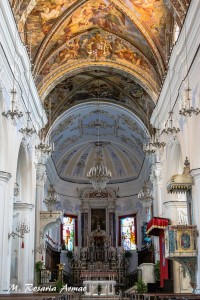The Castle of Lipari
As soon as you arrive to Lipari it is hard to avoid the sight of the 15th century mighty wall of Castello. . The castle’s area had been populated from the Neolithic era (4000 B.C.), and every civilization which settled there left an indelible print upon the area’s architecture. The archeological excavations have pointed out the overlap of the cultures , following each other during the centuries, a true paradise for the archeologists. The castle is surrounded by a long wall, built by the Spanish under Karl V domination around the middle 1500. Karl V , after the incursion of Barbarossa in 1544, with the consequent deportation of the greatest habitants’ part, decided to grant the city a reliable defensive system. The enter door leads to a gallery at exit, where an iron shutter was closed, and thanks to the existent trapdoors, boiling oils were poured. The first building to see is the Church of Santa Caterina, already dismissed, built between XVI and XVIII centuries, with the cross nave. The castle has other religious structures; between them the Chiesa dell’Addolorata dating back to the 16th century, with a richly decorated Baroque façade; further there is the Chiesa dell’Immacolata built in 1747. In front of the Church of Santa Caterina two wide excavation ditches show the rests of huts dating back the Bronze Age and being a part of a Greek-Roman urban plant. Next to the excavations there is Concordato staircase, built in the 10th century to connect Saint Bartholomew’s Cathedral to the urban center.
 Saint Bartholomew’s Cathedral, the main archipelago’s place of cult showing all its majesty, was re-built upon the ruins of antique pagan temples during the Hellenic Age, and then decorated more times. The last re-edification occurred as a consequence of the pirate’s Barbarossa invasion, who heavily destroyed the structure. Nowadays the church is presented as a Neo-baroque style, in its external part, and is neared by a bell tower. The interior of three naves, with the cross vault, is depicted with the episodes of Old Testament; it is also possible to admire the silver Statue of Saint Bartholomew, patron of the Aeolians, and the main archipelago’s icon of cult. From the Saint Bartholomew’s Cathedral you can reach the cloister of the antique Norman Abbey, of which only three sides were preserved because one of them was used during the construction of the right nave after the amplifying.
Saint Bartholomew’s Cathedral, the main archipelago’s place of cult showing all its majesty, was re-built upon the ruins of antique pagan temples during the Hellenic Age, and then decorated more times. The last re-edification occurred as a consequence of the pirate’s Barbarossa invasion, who heavily destroyed the structure. Nowadays the church is presented as a Neo-baroque style, in its external part, and is neared by a bell tower. The interior of three naves, with the cross vault, is depicted with the episodes of Old Testament; it is also possible to admire the silver Statue of Saint Bartholomew, patron of the Aeolians, and the main archipelago’s icon of cult. From the Saint Bartholomew’s Cathedral you can reach the cloister of the antique Norman Abbey, of which only three sides were preserved because one of them was used during the construction of the right nave after the amplifying.
On the south-west coast you can observe a Greek model reproduction of the Greek Theatre realized in 1976, which offers a suggestive background, with the view on Marina Corta port. Next to this area there is an archeological park , where Greek Age sarcophagi, found in Diana necropolis, are collocated. On the east part of this area there is a small Church of Santa Maria delle Grazie, constructed between the 12th and the 18th centuries upon the ruins of the already existent place of cult. Dulcis in fundo, in the castle’s area there are various halls of the Archeological Aeolian Museum: Bernabo Brea.






